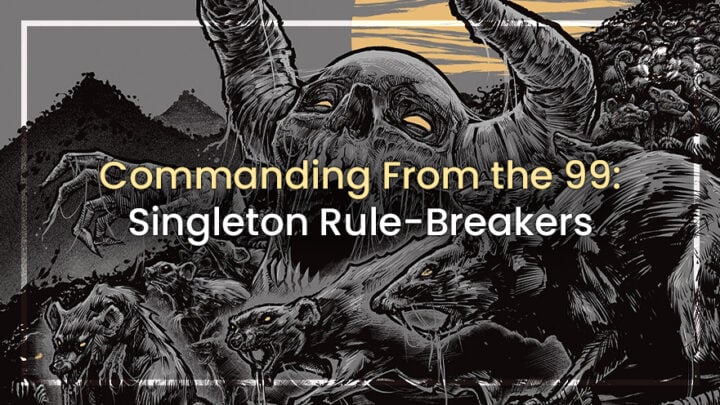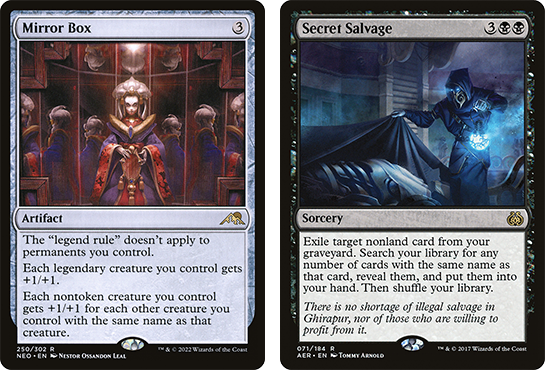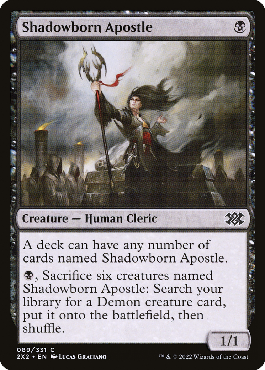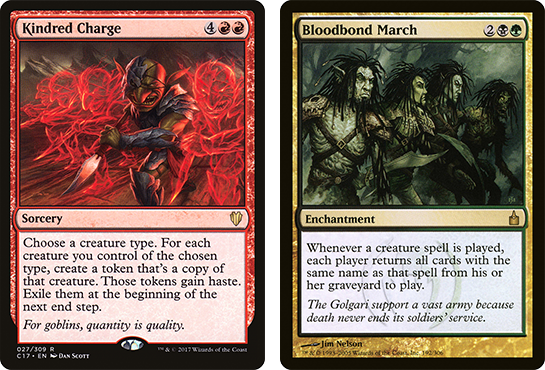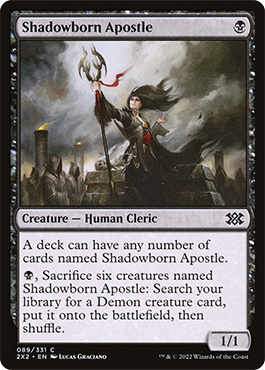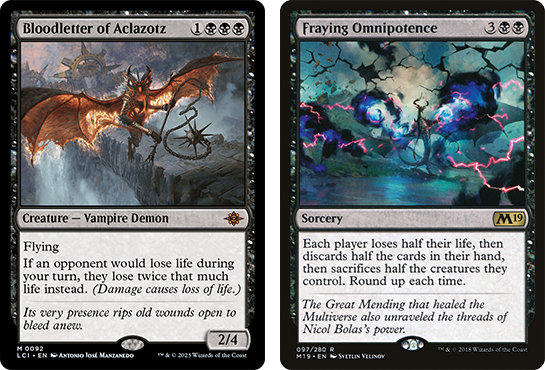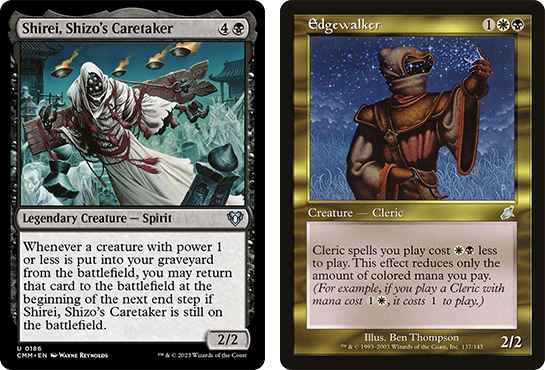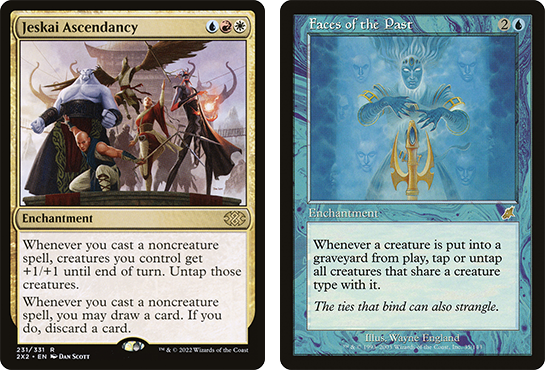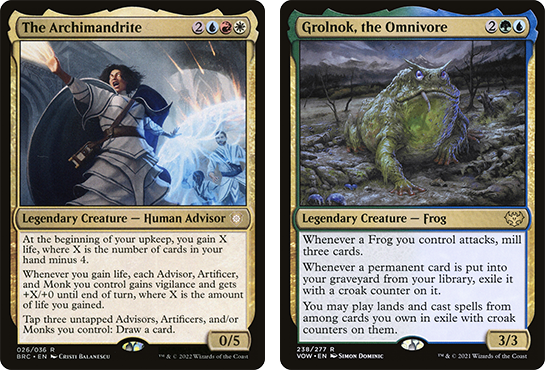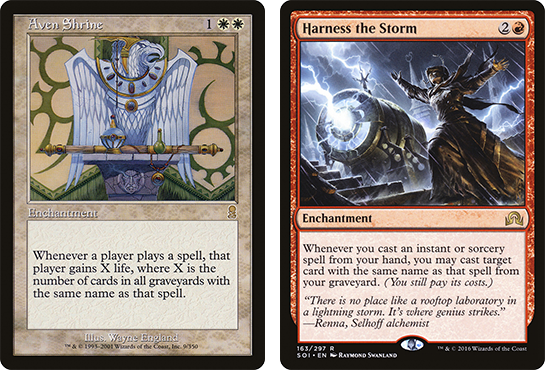Recently, we’ve been exploring a unique niche within Commander deckbuilding: decks where the most important and defining card isn’t the one in the command zone. Whether because of a rules nonbo or just lacking the legendary supertype, not every build-around is eligible to take command. But that doesn’t mean you can’t still make them work with a little ingenuity.
There may be no more obvious example of a card in the 99 defining its decklist than when that card is literally half of the deck! Only a handful of cards from across Magic history allow you to subvert Commander’s rules in this way, but they allow us to explore a completely alien approach to deckbuilding in the format.
TOO MUCH OF A GOOD THING
The kind of consistency achieved by playing so many copies of one card is an incredibly powerful upside in a format otherwise high on variance. When you know almost for a certainty that you’ll be playing your signature spell on most turns of the game, you can optimize every facet of your deck to fit that card.
However, it’s not always true that more duplicate copies means a stronger deck. The strength of this kind of deck is not the signature spell on its own, it’s that you can run the best possible support cards and guarantee they’ll synergize with almost everything you cast!
Adding in a reasonable number of interaction and utility cards also helps you spend mana efficiently in between signature spell casts, and makes you less predictable to opponents. I’d say the right number of copies is usually between 30 and 40. That means you’re drawing roughly three copies of your signature spell in your first 10 cards – definitely enough to push ahead with a gameplan, but not so many that you won’t have strategic options.
That said, the ideal number is always going to shift based on the exact way your signature works, and which support cards you’ve chosen to put around it – especially the one in your command zone.
THE RAT PACK
The oldest of our non-singleton cards is also the most straightforward. Each Relentless Rats you add to the board is more valuable than the last, eventually making your whole army too massive to resist. In 2004 this was a brand new concept, and simply playing a 35/25 Rats-Swamp split seemed like an exciting plan. But making this plan work in Commander is especially reliant on supporting cards to patch up its many weaknesses.
The good news is that in 2024, Relentless Rats no longer has to go it alone. Rat-typal decks are a community favorite and have a number of strong options at commander. Ashcoat of the Shadow Swarm basically doubles your damage output and ensures you’ll always have more copies of Relentless Rats to keep that damage trending up.
Karumonix, the Rat King has a similar role but offers a poison wincon instead of extra damage, while format classic Marrow-Gnawer fixes your lack of evasion and can generate a ton of extra bodies – even if those tokens won’t contribute to or benefit from the Relentless Rats effect.
This is where Rat Colony comes in: clearly designed as a “fixed” or modernized version of its Relentless cousins, it gives up on the toughness buff to instead scale with every rat-type creature. The lost toughness is a very significant issue, as it makes it very risky to send your swarm of X/1s into any significant blockers. But given how efficiently we can make Rat tokens compared to casting more Relentless Rats, the tradeoff still seems a clever one!
There are also a few non-typal commanders who are popular with these signature cards. Grenzo, Dungeon Warden effectively lets you pay 2 generic mana to both draw and cast a Rat (the power is only buffed while on the battlefield), while unlocking red cards like Shared Animosity and Kindred Charge. Jarad, Golgari Lich Lord lets you ignore combat and sacrifice your Rats to burn down the whole table; green offers such tech as Bloodbond March, Doubling Chant, Nantuko Shrine and Dual Nature.
THE APOSTLE POSSE
Shadowborn Apostle decks trade out the slow-but-steady scaling of the Rats for a much more sudden and explosive power spike at six copies in play. This first sacrifice will almost always summon Razaketh, the Foulblooded, which then only needs to eat another Apostle or two to tutor up a combo kill.
The incredibly low variance involved means that only enemy interaction can break up an otherwise clockwork turn five win – and they need to keep that boot on your neck the entire game lest you suddenly win off a Patriarch’s Bidding or similar mass reanimation spell!
Switching gameplans from beatdown to deterministic combo is another huge upgrade over the Rats decks. Not needing to worry about blockers and counting damage means that all your non-Apostle, non-wincon slots can be exclusively dedicated to putting Apostles on the board ASAP.
As usual this support starts in the command zone. K’rrik, Son of Yawgmoth and Morophon, the Boundless let you play Apostles without paying mana. Liesa, Forgotten Archangel, Taborax, Hope’s Demise, Athreos, God of Passage and Nalia de’Arnise all help load (or reload) your hand with more copies, assuming your opponents don’t just let you win right away. There’s also Shirei, Shizo’s Caretaker, which can make it much harder to slow down the accumulation of Apostles or enable a chain of activations inside of one turn cycle.
Adding white access does give those two-color commanders a leg up: Edgewalker makes Apostles completely free, while Return to the Ranks, Rally the Ancestors and Immortal Servitude make that sudden reanimation win much more probable.
But in spite of that my favorite commander for the Apostle deck is still Varragoth, Bloodsky Sire. Cheap enough to be relevant on the deck’s accelerated timeline, Varragoth can accelerate it yet further by digging up either a mass reanimation spell or the mighty Thrumming Stone. Either one will usually guarantee an Apostle activation and presumptive victory – if not, you can just try directly tutoring for your combo pieces with Varragoth!
Thrumming Stone is a beloved centerpiece for all of these non-singleton decks, and you could just as easily play Varragoth to go fetch it in the Rats list. But none of the others are quite as bloody-minded about tutoring into wins as the Apostles, so including it here felt right.
THE PETITIONER MILITIA
Like Shadowborn Apostle, Persistent Petitioners comes with a built-in non-combat win condition, so you already know where 99.9% of your victories are coming from. That gives deckbuilders the freedom – even the imperative – to dedicate every other spell slot towards enabling the Petitioner plan.
And yet the most popular Petitioners deck by FAR is one running Bruvac the Grandiloquent as commander, complete with the usual Bruvac-specific combos like Traumatize, Fleet Swallower and Maddening Cacophony. I’m not saying those combos are bad, I just don’t believe it’s correct to run Persistent Petitioners if you aren’t using them as your main wincon.
It doesn’t take much to establish a loop that mills out every opponent; you just need a way to untap the Petitioners between each activation. Jeskai Ascendancy plus a couple of mana dorks goes infinite with anything from Flickering Ward to Drafna, Founder of Lat-Nam to View From Above. Intruder Alarm just needs a token producer like Thraben Doomsayer – and cards that make human tokens also win with Faces of the Past and any sac outlet.
If you can’t go infinite, then you can fall back on efficient untapping effects like Quest for Renewal, Drumbellower, Seedborn Muse and Murkfiend Liege for a relatively fast clock, assuming you have enough copies of the signature card in play. For that, you can lean on Call to the Kindred, Distant Melody, Kindred Discovery and other blue tech.
Your choice of commander will be partially determined by which of these options you plan to support: The Archimandrite offers solid utility and even a combat damage wincon to Jeskai builds. The Master, Transcendent and Zellix, Sanity Flayer can be ready-made pieces for the Intruder Alarm combo.
Grolnok, the Omnivore might be most interesting of all, hyper-accelerating the deck by letting you mill yourself to find more pieces before eventually turning a huge pile of Petitioners on your foes (or just casting Thassa’s Oracle).
A SLURRY OF SORCERY
Making our signature spell a sorcery is definitely the “hard mode” for a non-singleton deck. Creatures unlock extra strategic options such as “blocking” and “attacking”, and even noncreature permanents would be positioned to abuse reanimation, flickering and similar mechanics.
This means a Dragon’s Approach deck will have one of the lower answers to “how many copies is too many” – you just need more non-signature cards to make the list function. At least Dragon’s Approach itself is worth the effort: it’s essentially both your Plan A and Plan B win conditions on one card!
Similarly to the Shadowborn Apostle deck, tutoring any dragon into play should be enough to win the game very quickly, so that clause should be the focal point. Using self-mill or looting effects to put more Approaches in your graveyard is far more efficient than trying to draw and cast five of them “fairly”. However, as the game drags on (or if you resolve something like Thrumming Stone) the balance starts to tip towards just burning the table out with Approach damage!
My preferred choice of commanders are mostly those that help pay for Approaches or get them where we need them to be: Neheb, Dreadhorde Champion, Edgin, Larcenous Lutenist, Mizzix of the Izmagnus, Solphim, Mayhem Dominus, and Birgi, God of Storytelling. Kess, Dissident Mage or other commanders which can flashback Approach are good because they let you focus entirely on getting copies to the graveyard, instead of having to hold a couple in hand.
That all-graveyard approach is even more relevant for the other non-singleton sorcery, Slime Against Humanity. Slime is almost a re-visit of the Relentless Rats design, stronger in some ways while weaker in others. The downsides are that it’s not a rat, and it’s not a creature card. The upsides are the easier-to-discount mana cost, built-in trample, and the ability to skip the slow early game buildup of power by aggressively milling copies of Slime before you try to cast any.
The fact that your Slime tokens will neither grow nor shrink once in play only drives home that you shouldn’t cast it to just make a 2/2. I’m all in on the mill commanders for this one: Shigeki, Jukai Visionary, Grolnok, the Omnivore, Tasigur, the Golden Fang, or Zellix, Sanity Flayer (with a green background). The sooner you start making some big-time Slimes the better, and the command zone is still the ultimate way to secure consistent access to effects you need.
IDENTITY VS. VARIETY
Building around and playing with these non-singleton cards is inevitably a polarizing experience. Their consistency violates one of the most fundamental and beloved tenets of the format, and their decks will often play out the same script game after game after game. That can become a drag, especially if opponents feel forced to warp their gameplan around slowing you down.
Paradoxically, their unique gameplay makes these decks a great antidote for those bored of building or playing with “normal” archetypes! Along with their strong sense of identity and focused deckbuilding incentives, this makes them an ideal “side deck” for enfranchised players to supplement their existing favorites.

Tom’s fate was sealed in 7th grade when his friend lent him a pile of commons to play Magic. He quickly picked up Boros and Orzhov decks in Ravnica block and has remained a staunch white magician ever since. A fan of all Constructed formats, he enjoys studying the history of the tournament meta. He specializes in midrange decks, especially Death & Taxes and Martyr Proc. One day, he swears he will win an MCQ with Evershrike. Ask him how at @AWanderingBard, or watch him stream Magic at twitch.tv/TheWanderingBard.

